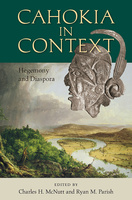Cahokia in Context
Hegemony and Diaspora
At its height between AD 1050 and 1275, the city of Cahokia was the largest settlement of the Mississippian culture, acting as an important trade center and pilgrimage site. While the influence of Cahokian culture on the development of monumental architecture, maize-based subsistence practices, and economic complexity throughout North America is undisputed, new research in this volume reveals a landscape of influence of the regions that had and may not have had a relationship with Cahokia.
Authority, Autonomy, and the Archaeology of a Mississippian Community
This book is the first detailed investigation of the important archaeological site of Parchman Place in the Mississippi Delta, a defining area for understanding the Mississippian culture that spanned much of what is now the United States Southeast and Midwest before the fifteenth century.
Archaeology of Domestic Landscapes of the Enslaved in the Caribbean
Rethinking Moundville and Its Hinterland
A much-needed synthesis of the rapidly expanding archaeological work that has taken place in the Moundville region over the past two decades, this volume presents the results of multifaceted research and new excavations.
Early and Middle Woodland Landscapes of the Southeast
Fourteen in-depth case studies incorporate empirical data with theoretical concepts such as ritual, aggregation, and place-making, highlighting the variability and common themes in the relationships between people, landscapes, and the built environment that characterize this period of North American native life in the Southeast.
New Directions in the Search for the First Floridians
Iconography and Wetsite Archaeology of Florida’s Watery Realms
Pre-Columbian Art of the Caribbean
Abundantly illustrated, this volume is a pioneering survey of the ancient art of the entire Caribbean region. While previous studies have focused on the Greater Antilles—Cuba, Haiti, the Dominican Republic, Puerto Rico, and Jamaica—this is the first book also to include the islands of the eastern Caribbean and their ties to pre-Columbian Venezuela.
The Cumberland River Archaic of Middle Tennessee
For thousands of years, the inhabitants of the Middle Cumberland River Valley harvested shellfish for food and raw materials then deposited the remains in dense concentrations along the river. Very little research has been published on the Archaic period shell mounds in this region. Demonstrating that nearly forty such sites exist, this volume presents the results of recent surveys, excavations, and laboratory work as well as fresh examinations of past investigations that have been difficult for scholars to access.
The Archaeology of Villages in Eastern North America
The emergence of village societies out of hunter-gatherer groups profoundly transformed social relations in every part of the world where such communities formed. Drawing on the latest archaeological and historical evidence, this volume explores the development of villages in eastern North America from the Late Archaic period to the eighteenth century.










